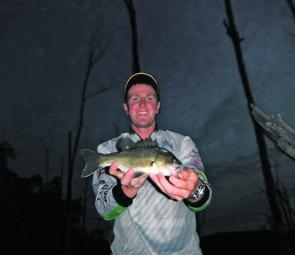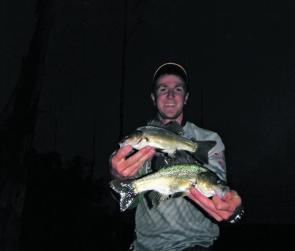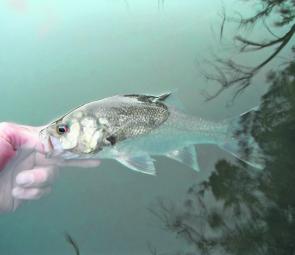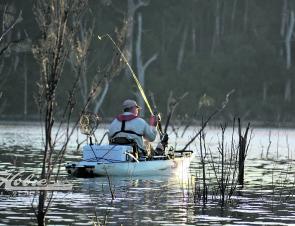I think it’s fair to say that the impoundment bass scene is now well and truly here to stay in Victoria. Consistent reports of Australian bass coming in by anglers in the know, coupled with a recent high profile tournament, word is spreading thick and fast about the potential of Blue Rock dam and it won’t be long at all before we have another great sports fishery on our hands.
Blue Rock is a large (208,000ML) dam on the Tanjil River in Gippsland designed to supplement cooling water supply to the coal fired power stations in the Latrobe Valley and to top up drinking water supplies for the local area. It has been stocked with trout for many years, but due to the depth and amount of structure in the lake it has historically been very hard work to obtain consistent results.
In recent years however, a stocking program run by the Department of Environment and Primary Industries has meant that 135,000 native Australian bass have been released into the lake. The program started in 2002, however there was a five year halt in stocking from 2004-08 due to an unreliable source of fingerlings. Things are back in full swing now and the lake is fishing better than ever.
As is the case when searching for any species of fish, finding the right structure is imperative to finding bass consistently. Sure, every now and then someone will luck across a good fish, but chances are that the people who know what they’re looking for and target those areas will be the ones who consistently catch bass.
So where do you start?
Looking for areas that provide shelter and food on a regular basis are the best places to begin. Blue Rock has an abundance of both standing and lay down timber, from right up on the banks to out in 30m of water, these trees all hold fish. Steep rock walls line the majority of the northern side of the lake, they have overhanging trees in places and the shade can easily be used to your advantage to prolong a bite period.
There are also many flats that can be fished on the southern side of the lake. The points of bays are often a great place to start, however spending the time to find smaller areas of the flats with a rubble bottom or some scattered timber will be guaranteed to hold more fish.
Bait is another factor that will greatly affect the areas where the fish will hold. There are a large number of small redfin, smelt and shrimp in the lake that the fish feed on, so finding and imitating these will put you on the right track.
Australian bass are an extremely aggressive and territorial fish, they will often hit a lure or bait out of aggression and not necessarily hunger. As mentioned earlier, imitating a food source is the key.
If fishing with lures, there are many different ways that you can cover different depths and types of bait. Redfin are often found in the mid depths of the lake and can be well represented with polycarbonate vibes and blades or shad style soft plastics. Fish these close to the bottom and with a lift and drop retrieve for best results.
Smelt are a longer, thinner profile bait often found around the edges of the lake that can be well represented with soft plastic flick baits on light or heavy jigheads depending on depth, even fish these weedless if you’re having trouble with snags.
The shrimp can and will be anywhere that there is structure, there are a huge variety of soft plastic shrimp on the market and it’s just a matter of finding one that you like the look and action of. Rig these on a jighead and sink them down the face of a rock wall or tree and hang on!
Stick to smaller sized lures to begin with, 50-80mm is great and if you find it necessary you can move up or down from there. One other technique can be to fish with spinnerbaits, these things can be thrown anywhere, have a seductive vibration and are highly snag-resistant. Throw them out, let them sink and wind them back. In the next year or two this type of lure will become a lot more popular than they already are on Blue Rock.
As far as colours go, stick with natural colours or go all out with bright pinks, yellows and greens, they all have their place and will work in different scenarios. But as tradition says, natural colours for sunny days and clear water, bright colours for dirty water and overcast days.
Bait fishing is also a great option, soaking fresh scrub worms has accounted for the majority of big 40cm+ fish that I have seen come out of the waterway, but due to the amount of sunken timber you will need to be prepared for snags.
Bass fishing is addictive at the best of best of times, but this rises to a whole new level when you start throwing surface lures. The way these fish erupt to eat bugs off the surface will have you hooked in a big way.
During the warmer months especially, bass can usually be seen or heard sucking off the surface, in this situation throwing floating lures that either stay on or just below the surface are the key. Remember you are trying to ‘match the hatch’ as it is commonly referred to, so throwing lures that mirror what is flying around or floating on the surface is a great place to start.
Cicadas, grasshoppers, frogs and flying ants are all fairly common down this way so that will give you some idea of what to gear up for, even a dry fly thrown in the right situation should have you seeing good results.
Don’t be afraid to let these lures sit either, it’s not too often you see a grasshopper swimming across the surface at a rate of knots.
Blue Rock Lake is approximately an hour and a half east of Melbourne near the small town of Willow Grove. From the Princess highway you can either turn off at Moe or Trafalgar depending on your direction of travel. The dam is an easy 20 minute drive north of the highway from either of these towns, just follow the signs to Willow Grove and from there, follow the signs to one of the two boat ramps, which are located at either end of the lake. There is ample trailer parking at both ramps and they both have nice shaded picnic areas that make it a great location for the family. There is even a great marked swimming area at the Tanjil River end.
As Blue Rock Lake is used partly for drinking water, it should be noted that there is a 10hp, 5 knot and 4.3m limit on boats, which is enforced. However these regulations are currently under review that will be completed shortly.
The best gear to bring is your standard 7’, 2-4kg spinning rod matched with a 2000 sized reel and 2-3kg line. If you’re intending to fish with lures, a graphite rod and braided line with a fluorocarbon leader will make things a lot easier and improve results.
Blue Rock is at its busiest over the summer months, and so is the bass fishing. Fish are more active once the water warms up and are also more widespread. However, fish will tend to school up more in winter and if you can find the schools you will generally catch fish. Not all of the techniques mentioned above will work to their best potential year round, they each have a different application, so as the seasons begin to transition, be prepared to change the way you target these fish.
At present the average size of these bass is around the 25cm mark, which is just under the legal limit of 27cm, but this average size is increasing consistently from year to year. Bass growth rates in Blue Rock are actually on par with the growth rates of the more publicised NSW bass impoundments, which is very encouraging for the future. A ‘good’ sized bass in the lake at present is around the 35cm mark, with only a handful of fish coming in at over 40cm in the last few years. This is sure to change for the better as time rolls on, although as the fish are only going to get bigger and the dam is going to be continually stocked with more of these great sports fish into the future.
Blue Rock is not the only stocked lake in this area; both Lake Glenmaggie near Heyfield and Lake Narracan near Moe have also been stocked with strong numbers of Australian bass and are achieving great results as well. These two lakes are a little different to Blue Rock in that they are for the most part a lot shallower, but they still have some great structure to be explored. All of the techniques mentioned earlier will work in these lakes in the right situations, you’ve just got to work out which one to use for the area you’re fishing.
So get out there and start covering some water, and while you’re out there don’t forget to check out the scenery, it really is a great part of the world.
For up to date information on all of these lakes you can visit the Southern Rural Water website at www.srw.com.au
1
Fisheries officers releasing part of another healthy year class of Australian bass into Blue Rock Lake. Photo courtesy of Marc Ainsworth.
2
Removing the hooks ready for release of another healthy Blue Rock bass.
3
This solid bass was spotted repeatedly taking bugs off the surface just on dark and didn’t take long to key in on a lure thrown in the same direction.
4
Make the most of a late bite period and see results just on dark. Ensure you’re prepared for it, as driving back in the dark through the timber can be fraught with danger.
5
Rob Wallace with two nice bass caught throwing surface lures during a period of high insect activity. The fish at this time were spotted regularly surfacing and quick to act on many different types of surface lures.
6
Releasing these fish is strongly encouraged as they are not able to reproduce in freshwater and are highly valued as a sports fish.
7
When the water level drops you can really see how much structure is out there, parts of the lake and river are lined with similar banks.
8
Kayak fishing is a popular option on Blue Rock due to the powerboat restrictions in place. It also opens up new areas that are otherwise inaccessible. Photo courtesy of Hobie Cat Australasia.
Facts
For local fishing tips and gear you can visit:
Bisho’s Bait and Tackle
12 June Ct, Warragul
5623 2899
Get Wet Outdoors
101 Argyle st Traralgon
5174 3999
Australian Bass stocking program
Australian bass are a native fish that inhabit the coastal flowing streams of Gippsland, east of Wilsons Promontory.
They are also found in New South Wales and southern Queensland rivers that flow to the sea. Both of those states have been very successful in creating new recreational fisheries by stocking bass into lakes and impoundments.
In Victoria, wild riverine populations of bass have declined, mostly because fish barriers have inhibited spawning migrations and the upstream return of juveniles. Fish barriers are being removed where possible, and fish ladders installed in other situations, however there remains an opportunity to boost remnant wild bass populations by stocking hatchery reared fish.
Stocking bass into Gippsland waters is relatively new. Some production and stocking occurred in 2002/03, but of a limited magnitude. After several years of attempting to secure reliable hatchery production in Victoria between 2004-08, more success came by working with existing private bass hatcheries in NSW.
Fingerlings are purchased each summer and released into waters agreed to by fisheries managers, anglers and water managers.
Gippsland stocking history
The table below indicates the number of fingerling bass released. On average these fish weigh about 1g each and measure 2-3cm.
| Location | 2002 | 2003 | 2009 | 2010 | 2011 | 2012 | 2013 | Total |
|---|---|---|---|---|---|---|---|---|
| Avon River | - | - | - | 15,000 | 3,000 | 3,000 | 3,000 | 24,000 |
| Blue Rock Lake | 25,200 | 10,000 | 30,000 | 15,000 | 15,000 | 15,000 | 25,000 | 135,200 |
| Thompson River, Cowarr Weir | - | - | - | 11,000 | 2,000 | 2,000 | 2,000 | 17,000 |
| Glenmaggie Lake | 29,250 | 15,000 | 22,000 | 22,270 | 10,000 | 10,000 | 10,000 | 118,520 |
| Macalister River (below Glenmaggie) | - | 2,350 | - | 4,000 | 2,000 | 2,000 | 2,000 | 12,350 |
| Mitchell River | - | - | - | 15,000 | 5,000 | 5,000 | 10,000 | 35,000 |
| Narracan Lake | - | - | - | 20,000 | 10,00 | 10,000 | 10,000 | 50,000 |
| Nicholson River | - | - | - | - | - | 35,000 | 10,000 | 45,000 |
| Tambo River | - | - | - | - | - | - | 10,000 | 10,000 |
| Total | 54,450 | 27,350 | 52,000 | 102,270 | 47,000 | 82,000 | 82,000 | 447,070 |
Flood events are thought to have impacted heavily on the bass stocked in 2002/03, particularly in Lake Glenmaggie. However captures of smaller, more recently stocked bass, from the Avon River, Lake Glenmaggie, Macalister River and Blue Rock Lake are very encouraging.












